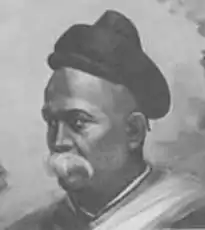Puneri Pagadi
The Puneri Pagadi is a distinctive style of turban, which is considered as a symbol of pride and honor in the city of Pune.[1] It was introduced two centuries ago.[2] Though it is a symbol of honour, the use of the pagadi has changed over the years and now it is also used on traditional days in colleges.[3] To preserve the identity of the pagadi, there were demands from the locals to grant it a Geographical Indication (GI) status.[3] Their demand was fulfilled and the pagadi became an intellectual property on 4 September 2009.[1][3][4][5][6]

History

The Puneri-style pagadi was introduced in the 19th century by Mahadev Govind Ranade, a social reformer. Later, it was worn by many leaders like Lokmanya Tilak, J.S. Karandikar, D.D. Sathye, Dr. Vitthalrao Gade, Tatyasaheb Kelkar and Datto Vaman Potdar.[2] The pagadi became more popular in 1973 after the Marathi play, Ghashiram Kotwal.[3]
Usage
The pagadi is used mostly on special occasions like wedding ceremonies and traditional days in schools and colleges. Youngsters wear it while performing the gondhal art form. The pagadi, being a symbol of honour, is also used as a souvenir. It also finds usage in period films and theatres.[3]
Granting of intellectual property right
The 10-membered Shree Puneri Pagadi Sangh had applied before the Geographical Indication Registry to get a Geographical Indication (GI) tag for the pagadi.[3] Great Mission Group Consultancy, which promotes intellectual property rights filed the application on behalf of them.[2] The aim was to make the pagadi recognizable, preserve its identity and also that of the Puneri culture. Consequently, on 4 September 2009, the Geographical Indication status was given to the headgear and the pagadi became the official cultural identity of Pune.[1][3][4][5][6] Thus, the pagadi got the Intellectual Property Right (IPR) and selling of any turban made outside Pune, under the name of Puneri pagadi became illegal. Along with the Puneri pagadi, IPR has been previously issued to Indian products like Darjeeling tea, Banarasi saris, Tirupati ladoos, among others.[4]
References
- "Indian association seeks IPR for 'Puneri Pagadi'". Business Standard India. Business Standard. Press Trust of India. 7 April 2009. Retrieved 12 June 2012.
- "Turban legend: Puneri Pagadi may soon get intellectual property tag". Mid-day. 6 April 2009. Retrieved 13 June 2012.
- Shruti Nambiar (2 August 2011). "The Pagadi Unravelled". The Indian Express. pp. 1–2. Retrieved 13 June 2012.
- "Puneri Pagadi gets GI tag; latest to join protected goods club". Zee News. 21 September 2009. Retrieved 13 June 2012.
- "Puneri Pagdi obtains geographical indication status". OneIndia News. 3 January 2010. Retrieved 13 June 2012.
- Chandran Iyer (22 September 2009). "Puneri Pagadi gets pride of place". Mid Day. Retrieved 13 June 2012.